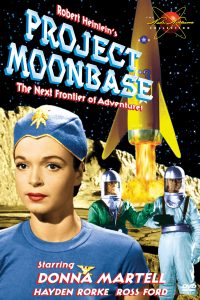
Basic Film Information
- Release Date: September 4, 1953
- Director: Richard Talmadge
- Writers: Robert A. Heinlein and Jack Seaman
- Starring: Ross Ford, Donna Martell, Hayden Rorke
Synopsis
In a futuristic version of 1970 America, there is a mission to take pictures on the other side of the moon, but it was infiltrated by an enemy agent. The enemy was defeated, however the ship had to make an emergency landing on the moon. There, the ship became the first moonbase.
Contemporary Reviews
- Rotten Tomatoes, though usually incorporates critical reviews, it only included user reviews due to its slightly more obscure nature. Users rated it a 8% liked it.
Background and Interesting Facts
- This movie and Cat-Women of the Moon (1953) were made using some of the same sets and costumes, and the two films were released within one day of each other.
- The film was shot in 10 days.
Analysis
Project Moonbase was an interesting, somewhat more progressive take on the 1970’s from a 1950’s America. In this movie, there were many predictions that were made, and therefore political stances that were expressed. One major stance that was included was a heavy focus on scientific advancement and funding to those programs. There were many very accurate parts to this movie in that aspect, and a lot of time went into planning and prediction went into this film before it began to be produced. The predictions that were made were relatively accurate to what occurred in later years; however, the movie had a much faster timeline.
In the US Constitution, there is a section that says the government should “promote the Progress of Science and useful Arts,” and that is something that had appeared to have happened in the film. From when the film was produced in 1953 to the decade it took place, there appeared to be an extraordinary amount of advancement. In the movie by 1970 there was a space station and space program that was well developed by 1970. From there, there was also advancements in the technology around the space program including rocket development, advancements in magnetic capabilities, as well as advancement in communication technology.
In terms of space travel and rocket developments, space travel became simpler and quicker by the 1970s in the movie, and rockets were better able to be used to maneuver around in space. The amount of time that this film took place in was an exaggeration, but not entirely inaccurate. The time frame for a trip to space was a few months in the movie. This was including the bureaucratic parts that they faced before the trip, and then as they began the trip, it lasted a few hours. Today it still takes a significant amount of time to get to space, but it has been getting shorter, as exemplified by this movie. In total, the technology advancements in this movie actually out-paced reality by about 10 years, but were all relatively close to real things that were developed.
In the space program in this movie, it also seemed that they allowed for slightly more equal opportunity for women to advance in a field of science. This, though close, was not entirely accurate. In the 1960s as the space program was developing, women were a key part in the coding of the technology, as well as many notable female mathematicians and physicists in charge of getting into space. In the movie, it seemed that there were mixed signals about what role women were to play in space exploration. On one hand, the first person to land on the moon was a woman; on the other hand, she gave up her title to be ranked below the man on board. This contradicting message left the movie up for interpretation as to where the space program should place women in importance.
The way that this movie predicted what would happen in the future was largely because of how the movie developed the political frame in which the movie took place. The movie took the stance that the government would put a lot of its funding towards the advancement of scientific achievement and with that, the political climate was also more accepting of women, leading to more females to work in the STEM fields. The space program that existed in this movie was informed by all of these things and developed to what the movie became.
Bibliography
Heinlein, Robert A., and Jack Seaman. Project Moonbase and Others. Burton, MI: Subterranean, 2008. Print.
IMDb. Project Moonbase (1953). 2016. Web Article. 16 November 2016.
Noonan, Bonnie. Women Scientists in Fifties Science Fiction Films. Jefferson, NC: McFarland, 2005. Print.
Rotten Tomatoes- Fandango. Project Moonbase (1953). 2016. Web Article. 16 November 2016.
Westfahl, Gary. “The Dark Side of the Moon: Robert A. Heinlein’s Project Moonbase.” Extrapolation 36.2 (1995): n. pag. Web.